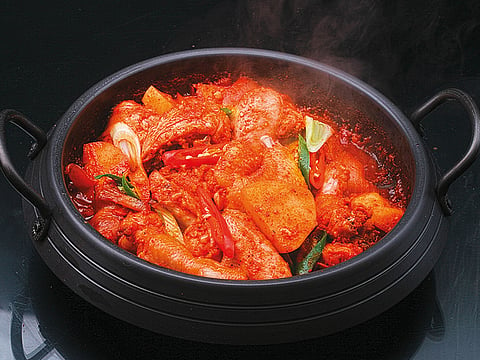Spice up your life
A new study has discovered a link between people who like spices and lower salt consumption, suggesting the answer to better health lies in the kitchen cupboard

Another week, another official health report. But this one could be good news for those who enjoy an aromatic curry or a hot bowl of chilli.
According to a new research in the American Heart Association’s journal Hypertension, subjects who enjoyed spicy foods appeared to eat less salt and have lower blood pressure, potentially reducing their risk of heart attack and stroke.
The salty effect
The study enrolled 606 adults in China and determined their preferences for salty and spicy flavours. Researchers then linked those preferences to blood pressure.
“Previously, a pilot study found that trace amounts of capsaicin, the chemical that gives chili peppers their pungent smell, enhanced the perception of food being salty,” said senior study author Zhiming Zhu, MD, professor and director of the Department of Hypertension and Endocrinology at the Third Military Medical University in Chongqing, China. “We wanted to test whether this effect would also reduce salt consumption.”
They found that, compared to those who least enjoyed spicy foods, participants
with a high spicy preference had blood pressure numbers and consumed less salt than participants who had a low spicy preference.
Researchers also used imaging techniques to look at two regions of the participants’ brains — the insula and orbitofrontal cortex — known to be involved in salty taste. They found that the areas stimulated by salt and spice overlapped, and that spice further increased brain activity in areas activated by salt. Authors said that this increased activity likely makes people more sensitive to salt so that they can enjoy food with less of it.
“If you add some spices to your cooking, you can cook food that tastes good without using as much salt,” Zhu said. “Yes, habit and preference matter when it comes to spicy food, but even a small, gradual increase in spices in your food may have a health benefit.”
Useful approach
Salt and sodium are often used interchangeably, but they are not the same. More than 75 per cent of the sodium Americans eat comes from processed, prepackaged and restaurant foods — not from the salt shaker. The American Heart Association recommends no more than one teaspoon of salt or
less per day.
Yasmine Haddad, Head Dietitian at nutrition firm Live’ly, finds the new study interesting and says any approach to diet that reduces salt intake will surely offer health benefits. “I believe it is a very useful study because research over the years has shown that when the intake of sodium increases so does the blood pressure,” she said.
“Sodium, which is mainly consumed as salt, is found in a wide range of foods and is often hidden in food you most likely didn’t even notice was salty. For example, French fries, processed soups and meats, stock cubes, and some salty cheeses.
“This study puts matters into perspective as the best way to avoid increased consumption of hidden salt is eating more homemade foods where sodium content can be controlled and adding a healthier alternative such as spices and herbs. It’s also important to remove the salt shaker from the table as every shake may deliver half a gram of salt. Eating less processed foods and increasing your intake of fresh foods will also help reduce your daily salt intake. Finally, make sure to check food labels for sodium content.”
Haddad added that a touch of spice is just what the doctor orders to minimise the damage of aging, as well as to help fight infection, chronic diseases such as diabetes, arthritis and cancer.
Indeed, new research finds that antioxidant-rich spices can hinder the formation of harmful compounds that are associated with aging, may inhibit tissue damage caused by high levels of blood sugar, and may even reduce inflammation that affect the joints or the gastrointestinal tract.
Medicinal properties
In addition, the bioactive compound capsaicin found in chilli helps increase metabolism, enhances satiety, and reduces hunger. It has a thermic effect which means that more body energy is needed to process it. This versatile and healthy additive is not only used for medicinal purposes but also for adding colour and enhancing flavour.
There are lots of different spices in the world, and some cuisines with the most flavourful dishes use them frequently. For the novice, experts suggest adding spices with a mild or subtle taste such as turmeric, cumin, saffron, and nutmeg. In addition, it is important to start by adding small amounts or a sprinkle and use one spice at a time to figure out if you enjoy the flavour or not.
For kids, incorporating herbs, spices and seasonings into their diet is a great way to help expand their taste buds and get them used to the flavours at an early age.
Dr Wafaa Ayesh, Clinical Nutrition Director at DHA, says that demonstrating the benefits of foods by scientific means remains a challenge, especially when compared with standards applied to pharmaceutical agents. She also said that an individual’s overall food choices have the biggest impact, rather than just narrowing down one group.
However, she added that spices have been used since ancient times for a reason and that there is little doubting the benefits they can hold.
“Polyphenols, a type of plant compound, provides one of the main health benefits associated with spices,” she explained.
“Besides having anti-inflammatory properties, most spices are also rich in antioxidants, and some — such as cinnamon — have antioxidants that have been linked to lower inflammation as well as well as reductions in blood glucose concentrations in people with diabetes.”
These are all compelling reasons to ditch the takeaways and head to the supermarket instead to stock up on those magical, aromatic powders and seeds from across the globe.
Sign up for the Daily Briefing
Get the latest news and updates straight to your inbox



